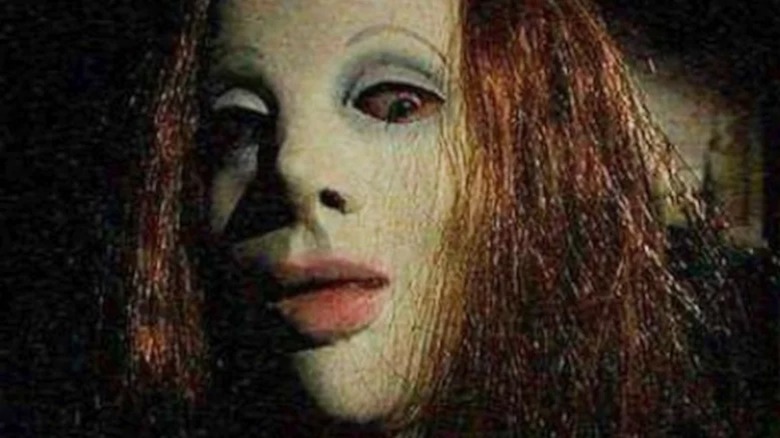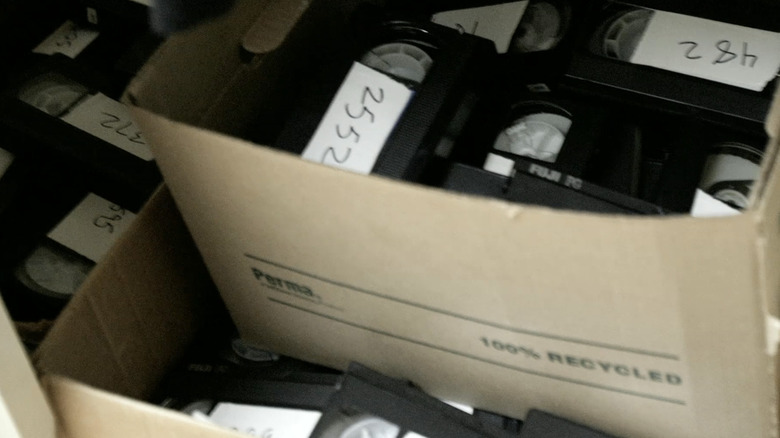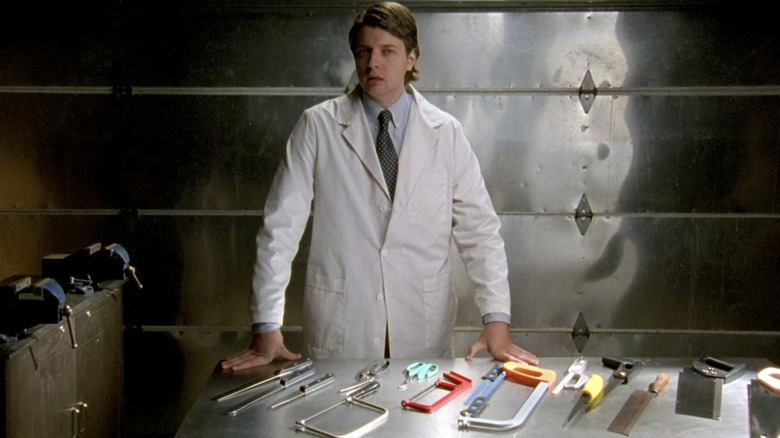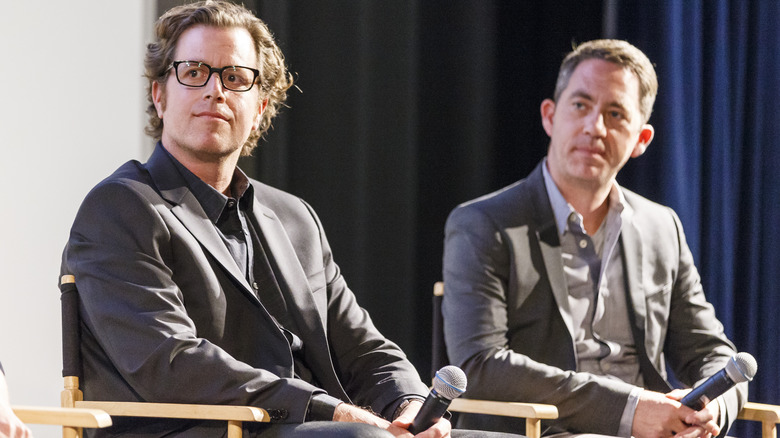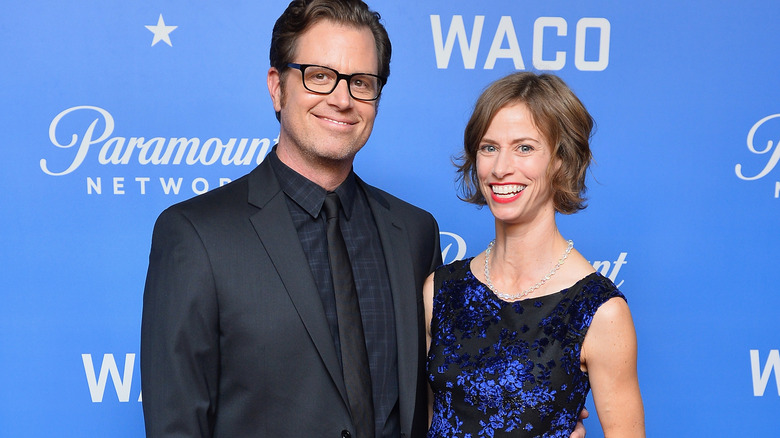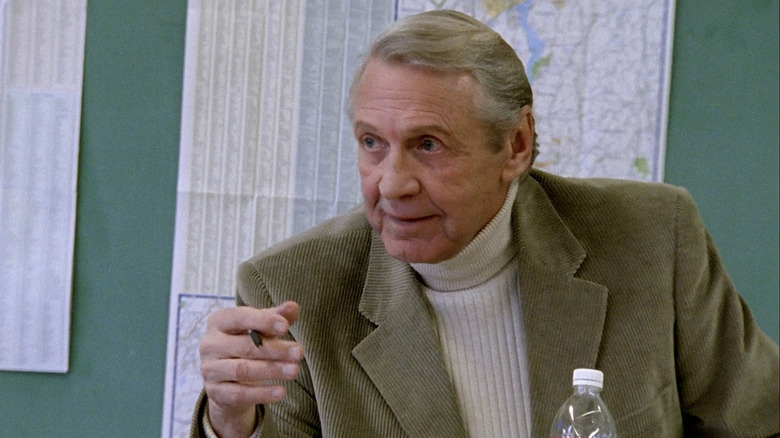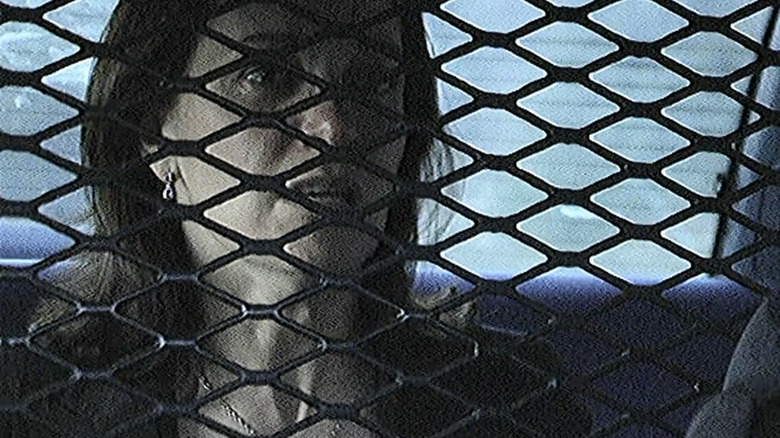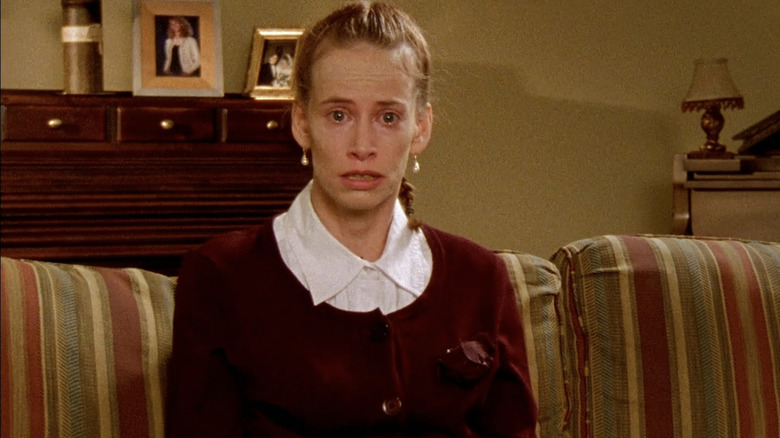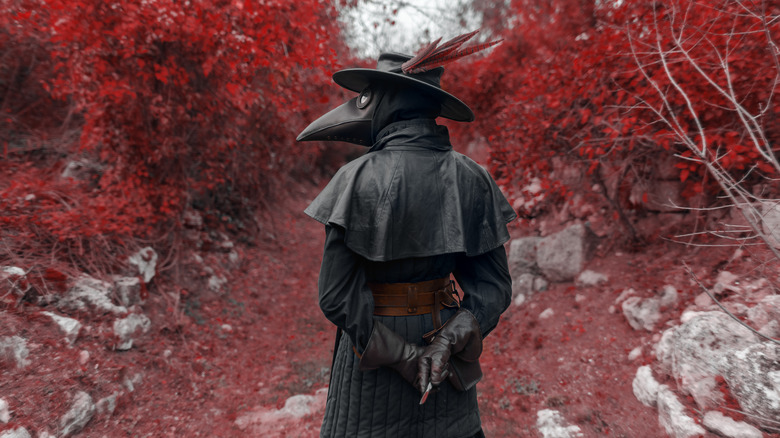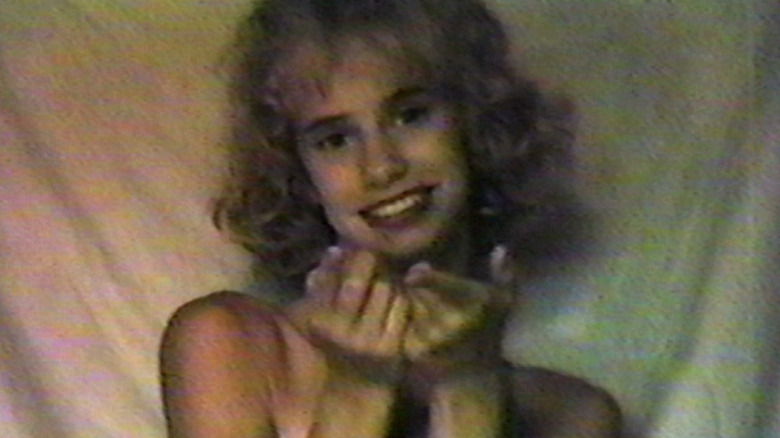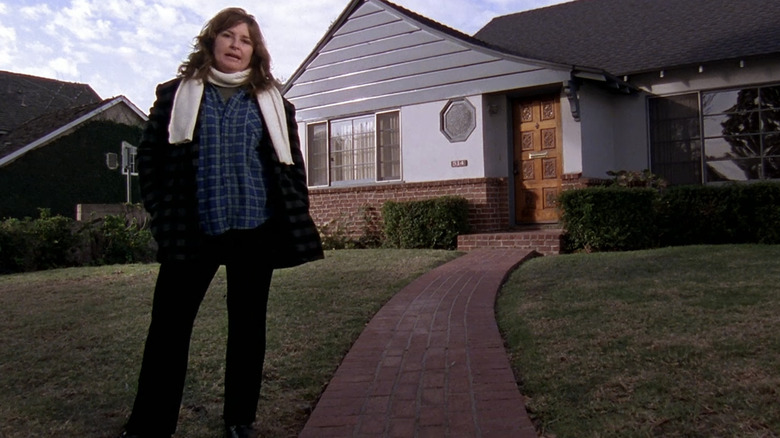The Untold Truth Of The Poughkeepsie Tapes
On the surface, 2007's "The Poughkeepsie Tapes" — with its unassuming title and series of talking-head segments — looks exactly like the true crime documentary it's pretending to be. Underneath, it's one of the scariest films ever made. Like a lot of great horror movies, it's a low-budget masterpiece that makes its behind-the-scenes limitations into virtues: If you don't have the money for effects, you have to master the power of suggestion and spend your time building up a skin-crawling sense of dread. If you can't hire big name actors, then your stars will feel more ordinary, real, and vulnerable.
"The Poughkeepsie Tapes" purports to be a true crime account of a massive collection of videotapes recovered from an abandoned house. The tapes document years of misery and depravity inflicted at the hands of the Water Street Butcher, a Poughkeepsie-based serial killer whose crimes were even more widespread, varied, and horrific than the authorities or public could have imagined. The Butcher liked to make home movies of himself stalking, kidnapping, terrorizing, and murdering his victims — and the scratchy, staticky video footage his reign of terror left behind will work its way into your nightmares.
Perhaps, taking a closer look at where those nightmares came from will help us all sleep a little more soundly. From inspiration to legacy, this is the untold truth of "The Poughkeepsie Tapes."
A lost movie
For years, if you wanted to watch "The Poughkeepsie Tapes," you were out of luck. Even though the film received what Variety Entertainment News Service called "a rapturous audience response" when it premiered at a 2007 film festival, the movie was shelved for the next decade.
It became a kind of cinematic cryptid, with its reputation surviving on rumors and word-of-mouth from the few horror fans lucky enough to see it. Rumors about its burial flew fast and thick. As Nightmare on Film Street put it, "Some said that it was because it was too scary. Others said that it was because it featured scenes of extreme torture. There were even some who thought the film was real and was pulled due to lawsuits from the victims' families." According to director John Erick Dowdle's interview with BlueCat, the film's lack of distribution was more accidental than anything else; when MGM, the initial distributor, had to bail out, the movie simply fell through the cracks.
Fans were left with no legal way to watch the movie — and to Dowdle's chagrin, even illegal methods could only turn up the inferior rough cut. "I wouldn't mind the piracy as much if it was at least the right movie," he told BlueCat.
In 2017, thanks to Shout Factory, fans were finally able to see "the right movie." A lot of films couldn't survive ten years of mystery and buildup ... but "The Poughkeepsie Tapes" succeeded at living up to its reputation.
Horror family tree
"Poughkeepsie" was following in some big found footage footsteps, but director John Erick Dowdle prefers to downplay the movie's connection to one of its most famous forerunners.
"We're not trying to sell a gimmick," he told Record Online in 2007. "Nobody goes and rents 'The Blair Witch Project' now, it doesn't hold up. This will." Dowdle was more inspired by the original "Halloween," which helped teach him about the impact of first-person killer POV. He praised its opening sequence to BlueCat, saying, "The closer you get to the victim, the more you are scared for them. It's kind of fun to make the audience the killer."
For fans, however, the long wait for wide release means "The Poughkeepsie Tapes" has a more striking "family resemblance" to a more disparate collection of films. With articles like this one at The Artifice theorizing that "the film was pulled from release to spare the sanity of the public," the movie feels like it belongs, accurately or inaccurately, with the banned horror films of yesteryear. That puts it in impressive company that includes "I Spit on Your Grave," "Salò," "The Texas Chain Saw Massacre," "The Evil Dead," "The Exorcist," and "Possession." After all, nothing bolsters a horror film's reputation like someone telling you that you can't see it.
From comedy to horror
"The Poughkeepsie Tapes" represented a major genre shifter for writer-director John Erick Dowdle and his brother, co-producer Drew Dowdle. Previously, as noted on BlueCat, the Dowdles had focused on comedy, making movies like "Full Moon Rising" and "The Dry Spell." The idea for their breakout film didn't come to them because they were immersed in the horror genre; it came because they were looking for a "lower budget movie that looked like it cost more money to make" and could be shot partly on video, which is cheaper than film. A true crime mockumentary seemed like the perfect fit ... but they weren't sure they could pull off such a radical change in genres.
Their horror debut was so impressive that their careers took off instantly. They went on to make "Quarantine" (a remake of the Spanish found footage horror film "REC") for a budget of $12 million (a substantial upgrade from the $450,000 they had for "The Poughkeepsie Tapes"), then "Devil" (from a story by M. Night Shyamalan), and the ambitious low-budget film "As Above, So Below," another found footage movie. They went from horror newbies to in-demand horror auteurs.
A family affair
As far as sibling creative teams go, the Dowdle Brothers may not be as legendary as the Wachowskis or the Coen Brothers, but they've carved out a niche for themselves in horror cinema. Director John Erick Dowdle has a long history of collaboration with his producer brother, Drew. In an interview with BlueCat, he explained that even as kids, he wrote out song lyrics and revised them on his brother's suggestions.
"I throw a bunch of paint at the wall, and he comes in and helps me sculpt it," he explained, saying their process hasn't changed. "He has a great analytical mind, and I've got a more intuitive mind – where the combination of the two works really well together."
There's more family involvement in "The Poughkeepsie Tapes" than just the two brothers, however. John Erick Dowdle's wife, Stacy Chbosky, also appears in the film as heartbreaking Cheryl Dempsey, who spends years getting tortured and brainwashed by the Water Street Butcher. Her brother, writer-director Stephen Chbosky, serves as the film's producer.
Stacy Chbosky's interview in John Norman's "Welcome to Our Nightmares" highlights that the Chboskys are long-time horror collaborators in their own right. She reminisced, "We even used my stuffed animals and our giant camcorder to shoot our own version of 'Friday the 13th.' My mom taped 'Family Ties' over it, otherwise I'm sure it'd be a cult classic today!"
The many fathers of the Water Street Butcher
What makes the serial killer in "Poughkeepsie" so sinister? According to Nightmare on Film Street, the film combines famous true crime elements to craft "a Serial Killer Chimera ... a masterful blend of every well-known serial murderer, allowing him to bore his way into the fear-center of every viewer's brain."
Nightmare on Film Street lists some of the most striking bits of this "DNA." The massive library of video-recorded crimes parallels the infamous "Toy Box Killer," David Parker Ray, and criminal partners Leonard Lake and Charles Ng, who, like the Water Street Butcher, also brainwashed and psychologically broke down their victims. The killer's invasive, shiver-inducing tour of Cheryl Dempsey's house has echoes of stalker-killers like Dennis Rader and Richard Ramirez.
One of the most unpleasant echoes is how the Water Street Butcher starts his killing with a young girl playing in her yard; many true crime scholars, as detailed on Crime Traveller, suspect that Ted Bundy's murders may have begun with him killing his 8-year-old neighbor when he was only 14. A fictional Bundy even appears in the film, advising detectives on how to catch their elusive prey. What he tells them, however, is what the real Bundy said about the Green River Killer.
The Water Street Butcher is a convincing serial killer because he's a composite, cobbled together from the strategies and methods of many killers who were all too real.
No money and no time
Horror is often the ideal vehicle for up-and-coming independent directors looking to prove themselves. American Film Market listed "extreme, clear-concept horror films" as one of the top three categories recommended for low-budget filmmakers in search of a breakout. As a mark of what's considered "low-budget" in the entertainment industry, the article looks at films made for $500k – $3 million.
"The Poughkeepsie Tapes" ducks below the low-water mark for that analysis, with Variety News Service confirming that it was made for only $450,000. The lack of money went hand-in-hand with a lack of time; John Erick Dowdle shot the film in only 15 days, spending only two more on post-production. The film smartly turns its lack of resources to its advantage via a found footage approach, making cheap, static-filled, low-quality visuals the product of its killer's camera and letting its largely unknown cast increase their plausibility as real people starring in a "documentary."
It's a credit to Dowdle that the lack of time doesn't show at all. The film doesn't feel rushed. In fact, a shorter shooting schedule may have been helpful to the actors saddled with disturbing roles; they didn't have time to get bored with their feigned terror.
More than meets the eye
"The Poughkeepsie Tapes" is grueling viewing; that emotional impact doesn't necessarily stem from an onslaught of gore, however. Review sites like Dark Universe note that "The Poughkeepsie Tapes" suggests its violence instead of depicting it outright. The faux-documentary approach means the audience hears a lot of graphic descriptions — but don't actually see the most gruesome elements play out on-screen.
Instead, "Poughkeepsie" derives most of its horror from agonizing tension. In an interview with BlueCat, director John Erick Dowdle said that he considers "the scariest scene in the movie" to be a long, dialogue-heavy sequence where the killer picks up an English woman who mistakes him for a police officer — a misconception he cultivates and encourages until it's too late for her to escape. The dread slowly mounts as this trapped character realizes the situation she's in. While the Water Street Butcher does kill her, the actual death scene feels like an afterthought compared to the sheer suspenseful terror of a scene that doesn't have the killer touch her at all. As Dowdle put it, "It's terrific, and it's awful, but it's all dialogue."
The most harrowing aspect
There are a lot of potential nightmares in "The Poughkeepsie Tapes," from disconcerting images (the Water Street Butcher creeping along on his hands and feet) to agonizing suspense sequences. The rawest and most lingering horror, though, might be the psychological destruction of Cheryl Dempsey. The all-too-realistic tactics the film shows are textbook brainwashing techniques.
When the killer captures Cheryl, she's a cheerful, ordinary 19-year-old girl. Over the course of years, he breaks her down into a terrified, tortured, and obedient "slave." He takes her name away from her, forces her into a doll-like mask, and makes her kill for him. He exercises a control over her mind that is so absolute — and so brutally enforced — that when she's finally rescued, she's terrified of ever accidentally saying something her listener doesn't want to hear. She insists that her captor truly loved her.
Cheryl's fate is tragic and haunting — and viewer commentary shows why it's the most disturbing and emotionally affecting part of the film. In a powerful editorial at Ghouls Magazine, Jenn Adams explains how Cheryl's story, though extreme, resonates with her own experience of abuse and even helped illuminate some aspects of her trauma for her, providing an invaluable sense of catharsis and connection that motivated her to publish her own story. Sometimes darkness can be illuminating, and sometimes even the most grim horror can be healing.
If you or someone you know is dealing with domestic abuse, you can call the National Domestic Violence Hotline at 1−800−799−7233. You can also find more information, resources, and support at their website.
A now-timely costume
One of the most iconic images from "The Poughkeepsie Tapes" is a plague doctor mask, sometimes worn by the killer as he torments his victims.
Back in 2007, when the film was shot, the long-beaked mask was somewhat unfamiliar to modern audiences. Elaborately masked killers are a staple of the horror genre, but they're usually found in slashers, not more realistic crime-horror hybrids. The Water Street Butcher isn't Jason Voorhees; he's a disturbing vision of a terrifying but real-feeling serial killer. The film justifies the killer's theatricality, however, via an interview with a vaudeville performer who explains that wearing a mask makes it easier for someone to disassociate from their actions and do increasingly worse things.
Years after the movie's release, the plague doctor mask has received an unfortunate, newfound resonance — or, more accurately, returned to its original resonance. After the COVID-19 pandemic set in, society resurrected the plague doctor image. There were even reports of a plague doctor strolling around Norfolk during lockdown, wryly acknowledging the past. It's an ominous sight, but, as Dread Central said, "As long as it's not the anonymous killer from 'The Poughkeepsie Tapes,' [we're] not too worried!"
How Stacy Chbosky made Cheryl Dempsey
Originally, Stacy Chbosky told John Norman for his book "Welcome to Our Nightmares," she planned to stay behind the scenes of "The Poughkeepsie Tapes." Sure, her husband was directing it, but she thought of herself more as a comedic actress, and there's nothing funny about "The Poughkeepsie Tapes."
The more she watched the casting process for the role, however, the more she felt drawn to Cheryl's character. She started to want the role — and when she got it, she put a lot of work into making her performance as realistic, heartbreaking, and painful as possible. Some of her research was academic — she read tragic accounts of women who had gone through similar ordeals — but a lot of it came down to raw experience. "I bound myself up ... to imagine how uncomfortable it would be to be kept that way for days," she told Norman. "My most powerful preparation was to repeat the words, 'You are the master and it pleases me to serve you' for an hour or two at a time. ... It hurt my voice; it was miserably depressing. In my imagination, I decided [the killer] made Cheryl repeat that phrase every waking moment for two years."
Chbosky's commitment to the role, and her thoughtfulness in crafting her performance, makes Cheryl particularly agonizing to watch. She's a major reason "Poughkeepsie" has such a lasting impact on audiences.
Fake serial killer, real city
Before filming for "The Poughkeepsie Tapes" started, director John Erick Dowdle had never been to his film's home base.
Why, then, did he choose Poughkeepsie as the stalking ground for his grimly prolific serial killer? For one thing, Dowdle told Record Online, he simply liked the name; Dowdle was also just drawn to the general region.
"There's something about upstate New York," he said in 2007. "It's a cosmopolitan area, but it has real nature and spaces where somebody could lurk and stalk people and do terrible things and probably stay unnoticed for a long time."
Many of the exterior location shots he captured during his three days in Poughkeepsie emphasize those natural spaces, turning them ominous. Every beautiful stretch of woodlands becomes the perfect spot to hide a dismembered body. Dowdle added that he was interested in the contrast between the natural beauty upstate and the sense of "some of the danger of New York City [spilling] off" as a kind of urban contaminant. Settings that aren't quite city and aren't quite country get the best — and worst — of both environments.
Although this might not sound like the best advertisement for the city of Poughkeepsie, Dowdle is quick to point out that the locals were thrilled to simply have their home in the spotlight.
Keeping viewers guessing
Viewers still take to the internet to find out whether the serial killer in "The Poughkeepsie Tapes" is real. Indeed, misconceptions about the Water Street Butcher's reality have been so persistent that Decider's article debunking the rumors came out years after the film's wide release. Gossip Chimp and The Cinemaholic ran similar pieces in 2020 and 2021. Clearly, the faux-documentary tactics John Erick Dowdle used for his movie have been effective, even in an era where audiences are internet-savvy and all but guaranteed to have seen plenty of mockumentaries.
In part, "Poughkeepsie" benefits from the true crime boom that has made serial killer documentaries ubiquitous. More than ever, audiences associate this kind of format with nonfiction; the lack of a mainstream theatrical release, meanwhile, has had audiences stumbling across it or finding it via word-of-mouth, making the movie's presentation more convincing.
Isolation helps, too. Watch "The Poughkeepsie Tapes" alone in the dark, fall under its spell ... and don't be surprised if you, too, find yourself taking to the internet with questions.
